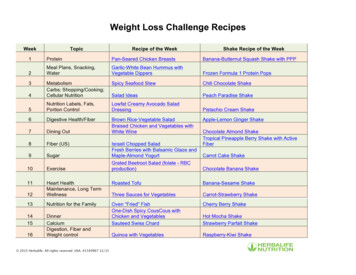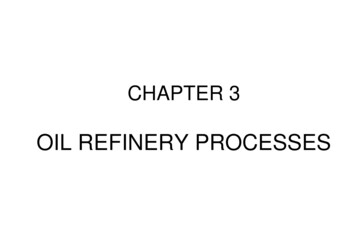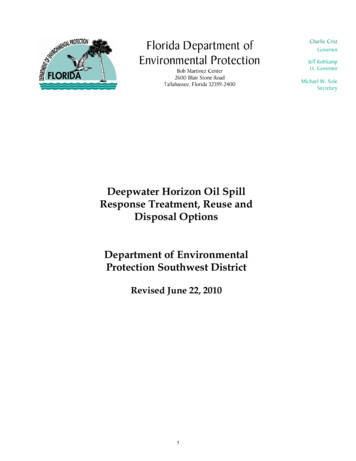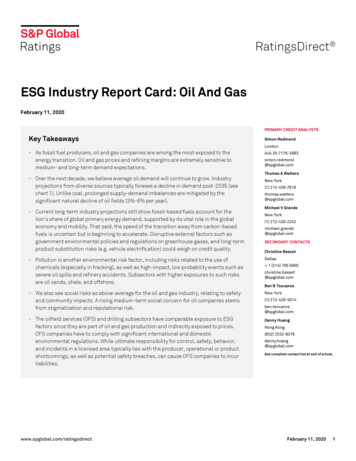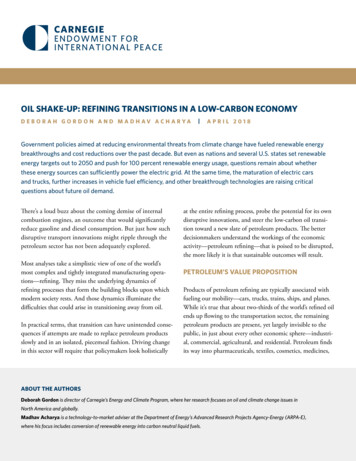
Transcription
OIL SHAKE-UP: REFINING TRANSITIONS IN A LOW-CARBON ECONOMYD E B O R A H G O R D O N A N D M A D H AV A C H A RYA APRIL 2018Government policies aimed at reducing environmental threats from climate change have fueled renewable energybreakthroughs and cost reductions over the past decade. But even as nations and several U.S. states set renewableenergy targets out to 2050 and push for 100 percent renewable energy usage, questions remain about whetherthese energy sources can sufficiently power the electric grid. At the same time, the maturation of electric carsand trucks, further increases in vehicle fuel efficiency, and other breakthrough technologies are raising criticalquestions about future oil demand.There’s a loud buzz about the coming demise of internalcombustion engines, an outcome that would significantlyreduce gasoline and diesel consumption. But just how suchdisruptive transport innovations might ripple through thepetroleum sector has not been adequately explored.Most analyses take a simplistic view of one of the world’smost complex and tightly integrated manufacturing operations—refining. They miss the underlying dynamics ofrefining processes that form the building blocks upon whichmodern society rests. And those dynamics illuminate thedifficulties that could arise in transitioning away from oil.In practical terms, that transition can have unintended consequences if attempts are made to replace petroleum productsslowly and in an isolated, piecemeal fashion. Driving changein this sector will require that policymakers look holisticallyat the entire refining process, probe the potential for its owndisruptive innovations, and steer the low-carbon oil transition toward a new slate of petroleum products. The betterdecisionmakers understand the workings of the economicactivity—petroleum refining—that is poised to be disrupted,the more likely it is that sustainable outcomes will result.PETROLEUM’S VALUE PROPOSITIONProducts of petroleum refining are typically associated withfueling our mobility—cars, trucks, trains, ships, and planes.While it’s true that about two-thirds of the world’s refined oilends up flowing to the transportation sector, the remainingpetroleum products are present, yet largely invisible to thepublic, in just about every other economic sphere—industrial, commercial, agricultural, and residential. Petroleum findsits way into pharmaceuticals, textiles, cosmetics, medicines,ABOUT THE AUTHORSDeborah Gordon is director of Carnegie’s Energy and Climate Program, where her research focuses on oil and climate change issues inNorth America and globally.Madhav Acharya is a technology-to-market adviser at the Department of Energy’s Advanced Research Projects Agency-Energy (ARPA-E),where his focus includes conversion of renewable energy into carbon neutral liquid fuels.
Figure 1: Petroleum in Daily LifeCommon Petroleum ProductsConsumer Fuels Gasoline Diesel Heating Oil Propane Kerosene LiquefiedPetroleum Gas Natural GasCommercial and Industrial Fuels Bunker Fuel Jet Fuel Petroleum Coke Fuel Oils andDistillatesIndustrial Inputs Petrochemicals SulfurInfrastructure Asphalt TarHousehold Cleaning Products Trash Bags Candles Paint Roofing/Insulation Carpet/UpholsteryPersonal Items Clothes Glasses/Contacts Dentures Toys/CrayonsOther Paraffin Wax LubricantsPetroleum in Common ProductsHealth and Beauty Cosmetics Shampoo/Soap Bandages Petroleum Jelly Vitamin CapsulesElectronics Computers Televisions SmartphonesNote: This not an exhaustive list; oil is used as feedstock for thousands of consumer goods and i ndustrial processes.electronics, and thousands of other common consumerproducts (see figure 1 for examples).Even renewable energy sources such as wind turbines andsolar panels require oil in their manufacturing, installation,and upkeep. And the millions of new electric vehicles (EVs)envisioned to reduce demand for oil contain many plasticparts (such as seats, dashboards, and bumpers) and rubbertires that are also derived from oil. So, while an EV doesn’tneed to be fueled by oil, its existence still involves oil and itsmany by-products.The sheer diversity of the resource’s applications has embedded oil in society over the course of millennia. As long ago2as 4,000 BCE, petroleum asphalt was quarried and usedas mortar between building stones, as caulking for ships,as waterproofing for baths, and as an adhesive for weaponhandles. In China, by 1 AD, bamboo pipes carried oil andgas into homes for heat and light. The invention of the steamengine in the mid-1700s sparked the use of coal in transportation. But coal would soon be replaced as the dominantsource of energy by petroleum when the first modern oil wellwas drilled in 1859.The gush of crude oil that followed inspired new ways toget value from this commodity. In its raw form, crude oil isessentially useless to consumers. But after it is converted intopetroleum products during the refining process, it is incredibly
valuable. Today, the petroleum industry is the largest in theworld, bigger than all other raw material markets combined.TURNING OIL INTO PETROLEUM PRODUCTSA modern oil refinery is a gargantuan system of processingequipment that heats, cleaves, and mixes each drop that it isfed into something of value. This process entails a complicated balancing act that must take into account both the technical and the economic feasibility of turning useless crude oilinto usable petroleum. In order to accomplish this, very littleoil entering the refinery goes to waste. Such refining efficiencies make it difficult to achieve oil decarbonization goalsbecause eliminating individual petroleum streams requiresoverall system reconfiguration that may not bepossible under current conditions.The first oil refineries were little more than kettles for boilingoil into kerosene, a cleaner-burning lamp oil that replacedwhale oil and animal fat. Since then, major engineeringefforts transformed refining as Henry Ford launched theworld’s first mass-produced car in the early 1900s, the Second World War called for high-octane fuels for aircraft andsynthetic rubber for tires, and postwar car ownership and theuse of plastics exploded. The uptake of petroleum productsfollowed globally, fueled by policies that linked economicgrowth to energy use.Today, refineries operate in nearly every industrialized country, and oil feedstock and end-use petroleum products areshipped worldwide. By January 2018, 91 million barrels ofoil per day were being refined globally—roughly double thevolume in 1970 and nine times more than in 1950.The massive volume of oil and petroleum products movingaround the globe is underpinned by capital investments thatcover time periods of a half-century or longer, making themcostly to dismantle in response to climate change. Refineries continue to expand and adapt as new oils are produced,such as fracked condensates and oil sands, in order to meetpetroleum product demands.REGIONAL REFINING DIFFERENCESIn some areas of the world, refining is in fact expanding quiterapidly. These expansions extend refinery lifetimes, making itincreasingly difficult for nations to transition off oil. How thisaligns with meeting climate goals is cause for concern.Between 2010 and 2017, nations’ refining capacity—thevolume of crude throughput—grew markedly in the MiddleEast and parts of Asia: : India (68 percent), Iraq (54 percent),China (53 percent), the UAE (43 percent), Iran (41 percent),and Saudi Arabia (40 percent). In many of these countries,new refinery construction also took off in this time frame.For example, India’s Reliance Industries expanded its existingrefinery into the world’s largest single refinery complex with acapacity in excess of 1.2 million barrels a day. And additionalnew infrastructure is slated; in Iran and Saudi Arabia (wherethe ban on women driving will soon be lifted, potentiallyincreasing the consumption of gasoline and diesel), a totalof 8 million barrels per day of refining capacity is beingplanned.Even the massive U.S. refining sector, which is nearly twicethe size of its nearest competitor (China), increased capacityby 4 percent during this period. There were also many countries whose refining capacity remained constant, including inLatin America and elsewhere in Asia.These trends are driven by the need for greater short-termenergy security and economic returns. In much of theworld, the plan is for more oil to flow through refineries toconsumers.In Europe, refining trends are strikingly different. Otherthan Spain, where refining capacity increased appreciably (12percent), many European Union nations didn’t see a changein refinery throughput between 2010 and 2017. Overall,however, Europe’s refining sector has been in noticeabledecline—from Russia (down 6 percent) to France and theUK (down 29 and 26 percent, respectively).CARNEGIE ENDOWMENT FOR INTERNATIONAL PEACE 3
Figure 2: Global Petroleum Product DemandOther PetroleumProductsUnited StatesDieselOECD Americas(excl. U.S.)Jet FuelOECD EuropeGasolineOECD 2530Million Barrels per Day (2nd quarter, 2017)Note: Other petroleum products include products such as petroleum coke, lubricants, waxes, solvents, still gas, and sulfur. Ethane/Propane uses are split,depending on the region, between petrochemical feedstock (ethylene and propylene) and liquefied petroleum gas for fuel (propane and butane). Naphtha is amultipurpose petroleum product used to make high-grade gasoline, as a solvent (for example, as a paint thinner and in cleaning agents in dry cleaning), and todilute heavier oils.Source: Authors’ calculations using International Energy Agency data, OECD (graph, page 5) and non-OECD (graph, page 9), 17-08-11.pdf.Reductions in Europe did not counterbalance the uptickin oil refining and petroleum consumption in Asia and theMiddle East. While the OECD countries were once thelargest consumers of petroleum products, today non-OECDcountries are consuming nearly as much gasoline, diesel,jet fuel, and petrochemical feedstock (naphtha, ethane, andpropane) for further processing into plastics, fertilizer, andchemicals (see figure 2). This is particularly true for petrochemical feedstock; in non-OECD nations, a significantamount of financing is flowing into new and expandedprocessing plants needed to produce petrochemicals. And theother refined oil products made from a barrel of oil—suchas propane, petroleum coke, lubricants, waxes, solvents, andsulfur—are also in high demand in non-OECD countries.It doesn’t appear that non-OECD countries that currentlyconsume a growing proportion of the world’s petroleum products will be able to easily wean themselves off the myriad of oil4products. Those countries that try to cut consumption of selectproducts like gasoline and diesel could find it to be much morecomplicated than they expect, given the intricacies of refining.What is more, even if they succeed in refining and consuming less of individual products, they can export them. Theease with which petroleum products trade in internationalmarkets makes it all too easy for greenhouse gas emissions toleak beyond national borders.REFINING UNDER A DECARBONIZATIONIMPERATIVEA number of recent national and international decisions target the refining system. In 2015, the G7 nations called for afirst-of-its-kind complete decarbonization of their economiesby the end of the century. Here Europe has an edge on others;
with downward trends in refining and consumption, Europeancountries can bolster their climate goals with policies. Thegovernments of the UK and France—representing the secondand third-largest car markets in the European Union, respectively—announced plans to ban petroleum-fueled vehicles by2040. Germany’s Bundesrat passed a nonbinding resolution—more sweeping than the UK and France’s plans—that calledfor the European Commission to effectively ban internal combustion engine vehicles from EU roads by 2030. And Swedishautomaker Volvo stated that it would design only hybrid andelectric vehicles starting in 2019.In Asia, however, hefty investments in refining infrastructure and expanded operations are not clearly aligned withdecarbonization goals. So, as India and China work on plansto enable EVs—or perhaps ban cars that run only on fossil fuels—they are not sufficiently confronting the realitiesof how lower gasoline consumption will square with higherrefining capacity, especially in an economic sector that is soefficiently designed.Beyond cars and trucks, there are yet other disruptiveinnovations envisioned that, taken together, could shrinkthe refining sector’s current product slate. Tesla’s Elon Musk,for example, is discussing intercontinental rockets thatcould replace today’s airline travel. These could run directlyon natural gas, which requires simpler processing facilitiesthan a refinery. Musk, along with Virgin’s Richard Branson,launched the Boring Company, which is building a pilotscale hyperloop that uses pressurized tubes in undergroundtunnels to propel items at high speeds. Hyperloops wouldprovide regional transport for passengers and freight, replacing airplanes running on aviation fuel, trains using diesel,and cars and trucks that travel longer distances and do notlend themselves to electrification.The petroleum industry’s response to efforts to decarbonizetransportation has been quite varied. While European companies have started to slowly explore the opportunity to fuelelectric vehicles or invest in renewable power, U.S. companieshave tended to be more cautious, viewing the threat fromalternatives to be of low consequence even by midcentury.It is true that, at least in the near term, refineries in the Westcould export surplus gasoline displaced by EVs to nonOECD nations, especially those experiencing economicgrowth. (This is the most likely outcome of a slow increasein EV penetration.) Depressed gasoline and diesel prices thatstem from the surplus would ignite new product demand.And the fact that fuel formulations are more tightly regulatedin the West could cut out extra refining steps, marginallyincreasing those refiners’ profit margins. In other words,if OECD refiners secure product markets in non-OECDcountries, they may benefit economically even as domesticconsumption is curtailed. Alternatively, the price of certainpetroleum products, such as jet fuel, could rise as the consumption of gasoline and diesel fall.In the long term, there are a number of ways to remix andreprice the underlying components of oil into different product formulations that could also help the industry respond toshifts in the market. It is more a matter of the price of thoseproducts relative to their substitutes, although safety, availability, ease of use, and other factors also weigh in. Generally,the lower the price, the greater the market potential for newpetroleum product configurations.But if automotive decarbonization policies materialize andhasten to spread globally, their effect, in theory, will be toundo the gradual, historic expansion from kerosene in lampsto gasoline in cars to jet fuel in planes that the industry hasengineered over the past century. Such a major shift awayfrom individual, established petroleum products has neverbeen charted. Successfully decarbonizing refining will requirereconfiguring major refining enterprises with global assetsvalued at nearly 1 trillion. Product shortages and pricespikes could result, especially in the short term, if refinerscannot fulfill their market commitments to cost-effectivelysupply a wide array of petroleum products to consumersaround the world.REMAKING REFININGWhile financial gains from producing oil and trading itsby-products can be enormous, refineries—the middle menCARNEGIE ENDOWMENT FOR INTERNATIONAL PEACE 5
in the operation—have historically been far less lucrative,running on slim margins. When times are good, a singlerefinery with an optimal crude flow and strategic location canbe a cash cow. But unplanned downtime of even a few days(as happened in the United States after Hurricane Harvey insummer 2017) can quickly turn a refinery into a money pit.Just like airlines, which only make money when their planesare in the air, refineries only make money when they’re running flat out, making a full slate of petroleum products.But what happens if society no longer utilizes a growing portion of a refinery’s products? In principle, large portions ofthe product slate including petrochemical feedstock, gasoline,diesel, and fuel oil can be replaced in the short run throughalternate routes (see figure 3 for the major products of refining). However, jet fuel, asphalt, lubricants, waxes, tar, andsulfur cannot; here it will be technologically more challenging—or perhaps even impossible—to develop market-ready,affordable, low-carbon substitutes.The process of replacing jet fuel will certainly be far slowerthan the adoption of EVs, for instance. Bio-jet fuel is manufactured from renewable feedstocks such as sugar, corn,or forest wastes. While bio-jet fuel is being made in smallamounts, it will likely be many decades before all airportsand aircraft are retrofitted for its universal, safe use. The prospect that liquid fuels will be obtained directly from renewableenergy (the so-called solar fuels) is even more distant.The same is true of a product as humble—and cheap—asasphalt. Solar roadways, recycled tires and printer toners, andlow-greenhouse-gas cement notwithstanding, the residual solids left over from refining heavy oils will continue to providepavement on which cleaner cars are driven for countless miles.If EVs replaced gasoline-powered cars or bio-based petrochemical feedstocks replaced ethane, for example, a refinery wouldnot be able to sell the isolated, displaced commodities in itsproduct slate. In response, markets would drive the value ofthese displaced products to zero; but refiners would still try toderive some benefit from their original oil building blocks.6There is a range of options refiners would want to consider. They could burn the “zero-value” products to generate energy. While this would help refiners efficiently use alltheir products, it would not reduce overall greenhouse gasemissions. Additional carbon-capture equipment might berequired on-site, which would greatly increase cost and shiftoperational priorities.Alternatively, they could develop new formulations of existing products or create new petroleum products altogetherusing these unwanted molecules, provided that these optionsare technically feasible and affordable, and that they achieveclimate goals.Reworking all the processes in the refinery so that moleculescan be converted into a subset of desired end products is alsoa possibility. Such change will come at a price. Refinery modifications tend to be very capital intensive; witness the tens ofbillions of dollars that the United States spent a decade agoto retrofit its refineries so they could process Canadian oilsands. In the long run, large, integrated refinery-petrochemical plants could give way to smaller, bespoke operations thatconvert different feedstocks into a small number of finishedproducts.Or refiners could explore using new techniques withmicrobes and nanotechnology to effectively refine oil underground in order to selectively produce low-carbon petroleumproducts. The complexity of such a task would likely bebeyond the scope of any single petroleum producer.Any of these options, as well as other future possibilities,could result if refiners jettison parts of their product slate.This could further complicate decarbonization efforts.MAKING THE SHIFTEnergy transitions typically take much longer than policymakers envision. A new approach to oil refining will requiremajor modifications to the long-honed, durable petroleumsystem. If economy-wide decarbonization is going to be
Prospects for Lower Carbon SolutionsFigure 3: Refining Shifts to Low-Greenhouse-Gas Product SlatesGasoline and Diesel(cars, trucks)LOW-GHG SUBSTITUTESLOWPETROLEUM PRODUCTSDirect From Natural Gas(no methane leakage)Fuel Oils and Distillates(engines, boilers)Liquefied Petroleum Gas: Propane and ButaneBio-Based Liquefied Petroleum Gas(cooking, heating, vehicles)Ethane and NaphthaBio-Based Petrochemical Feedstock(ships, power plants, industry)Asphalt(roadway paving)Hydrogen(refining, fertilizers, pharmaceuticals, polymers)Cost and Technical Barriers(plastics, solvents, fuel additives)Residual Fuels and Bunker FuelsElectric Vehicles(with renewable power)Liquefied Natural GasLow-GHG ConcreteRenewable Electrolysis of WaterJet Fuel(airplanes)Lubricants(transport and industrial applications, metalworking)Bio-Based AlternativesWaxes(foods, cosmetics, polishes, coatings, 3D printing)TarSulfur(rubber, gunpowder, fungicide, medicines)HIGH(paints, sealers)Surface Mining From VolcanoesCARNEGIE ENDOWMENT FOR INTERNATIONAL PEACE 7
accomplished, it will not be enough to simply advance salesof cleaner substitutes like EVs. It is one thing to craft a policythat steers cars and trucks away from petroleum. It is quiteanother to assume that these will result in successfully backing oil out of the economy.For the global refining sector to profitably make an evershrinking slate of products, the petroleum industry will needa twenty-first-century technology makeover. Making theshift against a dynamic backdrop of market, geopolitical, andsocial pressures on refiners will be even more difficult. Refining innovations will have to square with policy mandates tomeet decarbonization goals as well as address local environmental challenges. Refiners will have to be conscious of fickleconsumer preferences and changing product demands as theyrespond to disruptive innovations in all economic sectors.The challenge to develop new and retrofit old processeswill require mobilizing technical resources on national andinternational scales—especially in non-OECD countrieswhere new refining capacity is expanding, but also in theUnited States where there is a large amount of existing capacity. Even if new manufacturing units, such as bio-refineriesor renewable-energy-powered electrolyzers, are technicallyfeasible, entirely new processes and capital will need to be putin place to make the necessary shifts a reality, and the pricetag for that will not be low. It might require the establishment of joint public-private blue-ribbon panels to identifykey technical gaps in the fuel and chemical manufacturingprocesses of the future. This could be integrated with creativemechanisms and competitions, such as the X Prize, that fundthe design and implementation of models that solve challenges on a global scale.As momentum builds behind efforts to shift to a low-carbonglobal economy, it is critical to start thinking about howdecarbonization efforts will impact a strategically honedindustry like oil refining that’s over a century in the making.To minimize unintended energy, economic, and environmental consequences, a road map for the future needs to accountfor all petroleum shifts, not just the ones that capture themost attention.For links to sources, view this article at CarnegieEndowment.org.The authors would like to thank former Carnegie colleague David Livingston, whose contributions were instrumental to early versions of thispublication. We are grateful to Smriti Kumble (Carnegie), Jigar V. Shah (International Finance Corporation), and colleagues at ARPA-E (U.S.Department of Energy) for providing their feedback and comments. The Carnegie communications team, as always, provided excellent support,including Rebecca White and Jocelyn Soly in their consulting capacities.CARNEGIE ENDOWMENT FOR INTERNATIONAL PEACEThe Carnegie Endowment for International Peace is a unique global network ofpolicy research centers in Russia, China, Europe, the Middle East, India, and theUnited States. Our mission, dating back more than a century, is to advance peacethrough analysis and development of fresh policy ideas and direct engagementand collaboration with decisionmakers in government, business, and civil society.Working together, our centers bring the inestimable benefit of multiple nationalviewpoints to bilateral, regional, and global issues. 2018 Carnegie Endowment for International Peace. All rights reserved.Carnegie does not take institutional positions on public policy issues; the viewsrepresented herein are the authors’ own and do not necessarily reflect the views ofCarnegie, its staff, or its entT H E G LO BA L T H I N K TA N K CarnegieEndowment.org
try, and oil feedstock and end-use petroleum products are shipped worldwide. By January 2018, 91 million barrels of oil per day were being refined globally—roughly double the volume in 1970 and nine times more than in 1950. The massive volume of oil and petroleum products moving around the globe is underpinned by capital investments that





